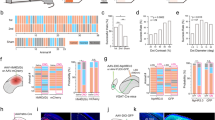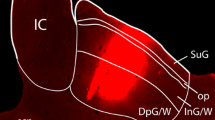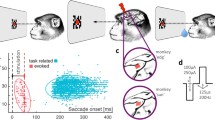Abstract
Physiological and behavioral studies in cat have shown that corticotectal influences play important roles in the information-processing capabilities of superior colliculus (SC) neurons. While corticotectal inputs from the anterior ectosylvian sulcus (AES) play a comparatively small role in the unimodal responses of SC neurons, they are particularly important in rendering these neurons capable of integrating information from different sensory modalities (e.g., visual and auditory). The present experiments examined the behavioral consequences of depriving SC neurons of AES inputs, and thereby compromising their ability to integrate visual and auditory information. Selective deactivation of a variety of other cortical areas (posterolateral lateral suprasylvian cortex, PLLS; primary auditory cortex, AI; or primary visual cortex, 17/18) served as controls. Cats were trained in a perimetry device to ignore a brief, low-intensity auditory stimulus but to orient toward and approach a nearthreshold visual stimulus (a light-emitting diode, LED) to obtain food. The LED was presented at different eccentricities either alone (unimodal) or combined with the auditory stimulus (multisensory). Subsequent deactivation of the AES, with focal injections of a local anesthetic, had no effect on responses to unimodal cues regardless of their location. However, it profoundly, though reversibly, altered orientation and approach to multisensory stimuli in contralateral space. The characteristic enhancement of these responses observed when an auditory cue was presented in spatial correspondence with the visual stimulus was significantly degraded. Similarly, the inhibitory effect of a spatially disparate auditory cue was significantly ameliorated. The observed effects were specific to AES deactivation, as similar effects were not obtained with deactivation of PLLS, AI or 17/18, or saline injections into the AES. These observations are consistent with postulates that specific cortical-midbrain interactions are essential for the synthesis of multisensory information in the SC, and for the orientation and localization behaviors that depend on this synthesis.
Similar content being viewed by others
References
Avendano C, Rausell E (1988) Organization of the association cortical afferent connections of area 5: a retrograde tracer study in the cat. J Comp Neurol 278:1–33
Benedek G, Mucke L, Norita M, Albowitz B, Creutzfeldt OD (1988) Anterior ectosylvian visual area (AEV) of the cat: physiological properties. Prog Brain Res 75:245–255
Burton H, Robinson CJ (1987) Responses in the first or second somatosensory cortical area in cats during transient inactivation of the other ipsilateral area with lidocaine. Somatosens Res 4:215–236
Clarey JC, Irvine DRF (1986) Auditory response properties of neurons in the anterior ectosylvian sulcus of the cat. Brain Res 386:12–19
Clemo HR, Stein BE (1982) Somatosensory cortex: a “new” somatotopic representation. Brain Res 235:162–168
Cornwell P, Ravizza R, Payne B (1984) Extrinsic visual and auditory cortical connections in the 4-day-old kitten. J Comp Neurol 229:97–120
Frens MA, Van Opstal AJ, Van der Willigen RF (1995) Spatial and temporal factors determine audio-visual interactions in human saccadic eye movements. Percept Psychophys 57:802–816
Gielen CCAM, Schmidt RA, Van Den Heuvel PJM (1983) On the nature of intersensory facilitation of reaction time. Percept Psychophys 34:161–168
Hardy SC, Stein BE (1988) Small lateral suprasylvian cortex lesions produce visual neglect and decreased visual activity in the superior colliculus. J Comp Neurol 274:527–542
Hughes HC, Reuter-Lorenz PA, Nozawa G, Fendrich R (1994) Auditory-visual interactions in sensory-motor processing: saccades versus manual responses. J Exp Psychol Hum Percept Perform 20:131–153
Huneycutt WS (1987) The influence of corticotectal circuitry on multisensory localization behavior. Thesis, Tomkins-McCaw Library, Virginia Commonwealth University, Richmond, Va
Imig TJ, Reale RA, Brugge JF (1982) The auditory cortex: patterns of corticocortical projections related to physiological maps in the cat. In: Woolsey CN (ed) Cortical sensory organization, vol III. Humana Press, Clifton, NJ
Kadunce DC, Wallace MT, Benedek G, Stein BE (1994) Crossmodal inhibition in multisensory neurons is based on unimodal receptive field organization. Soc Neurosci Abstr 20:1186
King AJ, Hutchings ME (1987) Spatial response properties of acoustically responsive neurons in the superior colliculus of the ferret: a map of auditory space. J Neurophysiol 57:596–624
King AJ, Palmer AR (1985) Integration of visual and auditory information in bimodal neurones in the guinea-pig superior colliculus. Exp Brain Res 60:492–500
Knudsen EI (1982) Auditory and visual maps of space in the optic tectum of the owl. J Neurosci 2:1177–1194
Lee CS, Chung S, Kim J, Park J (1991) Auditory facilitation of visually guided saccades. Soc Neurosci Abst 17:862
Malpeli JG, Schiller PH (1979) A method of reversible inactivation of small regions of brain tissue. J Neurosci Methods 1:143–151
McHaffie JG, Kruger L, Clemo HR, Stein BE (1988) Corticothalamic and corticotectal somatosensory projections from the anterior ectosylvian sulcus (SIV cortex) in neonatal cats: an anatomical demonstration with horseradish peroxidase and tritiated leucine. J Comp Neurol 274:115–126
Meredith MA, Clemo HR (1989) Auditory cortical projection from the anterior ectosylvian sulcus (field AES) to the superior colliculus in the cat: an anatomical and electrophysiological study. J Comp Neurol 289:687–707
Meredith MA, Stein BE (1983) Interactions among converging sensory inputs in the superior colliculus. Science 221:389–391
Meredith MA, Stein BE (1986a) Visual, auditory, and somatosensory convergence on cells in superior colliculus results in multisensory integration. J Neurophysiol 56:640–662
Meredith MA, Stein BE (1986b) Spatial factors determine the activity of multisensory neurons in cat superior colliculus. Brain Res 365:350–354
Meredith MA, Nemitz JW, Stein BE (1987) Determinants of multisensory integration in superior colliculus neurons. I. Temporal factors. J Neurosci 10:3215–3229
Meredith MA, Wallace MT, Stein BE (1992) Visual, auditory and somatosensory convergence in output neurons of the cat superior colliculus: multisensory properties of the tecto-reticulospinal projection. Exp Brain Res 88:181–186
Middlebrooks JC, Knudsen EI (1984) A neural code for auditory space in the cat's superior colliculus. J Neurosci 4:2621–2634
Miller JO (1982) Divided attention: evidence for coactivation with redundant signals. Cogn Psychol 14:247–279
Miller JO (1986) Time course of coactivation in bimodal divided attention. Percept Psychophys 40:331–343
Mucke L, Norita M, Benedek G, Cruetzfeldt OD (1982) Physiologic and anatomic investigation of a visual cortical area situated in the ventral bank of the anterior ectosylvian sulcus of the cat. Exp Brain Res 46:1–11
Norita M, Mucke L, Benedek G, Albowitz B, Katoh Y, Creutzfeldt OD (1986) Connections of the anterior ectosylvian visual area (AEV). Exp Brain Res 62:225–240
Olson CR, Graybiel AM (1987) Ectosylvian visual area of the cat: location, retinotopic organization and connections. J Comp Neurol 261:277–294
Palmer LA, Rosenquist AC, Tusa, RJ (1978) The retinotopic organization of lateral suprasylvian visual areas in the cat. J Comp Neurol 177:237–256
Perrott DR, Saberi K, Brown K, Strybel TZ (1990) Auditory psychomotor coordination and visual search performance. Percept Psychophys 48:214–226
Raab D (1962) Statistical facilitation of simple reaction times. Trans N Y Acad Sci 24:574–590
Rao CR (1973) Linear statistical inference and its applications, 2nd edn. Wiley, New York
Rauschecker JP, Korte M (1993) Auditory compensation for early cortical blindness in cat cerebral cortex. J Neurosci 13:4538–4548
Reinoso-Suarez F, Roda JM (1985) Topographical organization of the cortical afferent connections to the cortex of the anterior ectosylvian sulcus in the cat. Exp Brain Res 59:313–324
Rosner BA (1990) Fundamentals of biostatistics. PWS-Kent, Boston, Mass
Scanell JW, Blakemore C, Young MP (1995) Analysis of connectivity in the cat cerebral cortex. J Neurosci 15:1463–1483
Stein BE, Meredith MA (1993) The merging of the senses. MIT Press, Cambridge, Mass
Stein BE, Magalhaes-Castro B, Kruger L (1976) The relationship between visual and tactile representations in the cat superior colliculus. J Neurophysiol 39:401–419
Stein BE, Spencer RF, Edwards SB (1983) Corticotectal and corticothalamic efferent projections of SIV somatosensory cortex in cat. J Neurophysiol 50:896–909
Stein BE, Huneycutt WS, Meredith MA (1988) Neurons and behavior: the same rules of multisensory integration apply. Brain Res 448:355–358
Stein BE, Meredith MA, Huneycutt WS, McDade L (1989) Behavioral indices of multisensory integration: orientation to visual cues is affected by auditory stimuli. J Cogn Neurosci 1:12–24
Stein BE, Meredith MA, Wallace MT (1993) The visually responsive neuron and beyond: multisensory integration in cat and monkey. Prog Brain Res 95:79–90
Stein BE, London N, Wilkinson LK, Price DD (1996) Enhancement of perceived visual intensity by auditory stimuli: a psychophysical analysis. J Cogn Neurosci, in press
Tusa RJ, Palmer LA, Rosenquist AC (1978) The retinotopic organization of area 17 (striate cortex) in the cat. J Comp Neurol 177:213–235
Wallace MT, Stein BE (1994) Cross-modal synthesis in the midbrain depends on input from association cortex. J Neurophysiol 71:429–432
Wallace MT, Meredith MA, Stein BE (1992) Integration of multiple sensory inputs in cat cortex. Exp Brain Res 91:484–488
Wallace MT, Meredith MA, Stein BE (1993) Converging influences from visual, auditory and somatosensory cortices onto output neurons of the superior colliculus. J Neurophysiol 69:1797–1809
Wallace MT, Wilkinson LK, Stein BE (1994) Sensory representations and the integration of multiple sensory cues in the monkey superior colliculus. Soc Neurosci Abstr 20:1186
Wilkinson LK, Meredith MA, Stein BE (1992) Cortical deactivation disrupts multisensory orientation. Soc Neurosci Abstr 18:1031
Zahn JR, Abel LA, Dell'Osso LF (1978) Audio-ocular response characteristics. Sens Proc 2:32–37
Author information
Authors and Affiliations
Rights and permissions
About this article
Cite this article
Wilkinson, L.K., Meredith, M.A. & Stein, B.E. The role of anterior ectosylvian cortex in cross-modality orientation and approach behavior. Exp Brain Res 112, 1–10 (1996). https://doi.org/10.1007/BF00227172
Received:
Accepted:
Issue Date:
DOI: https://doi.org/10.1007/BF00227172




